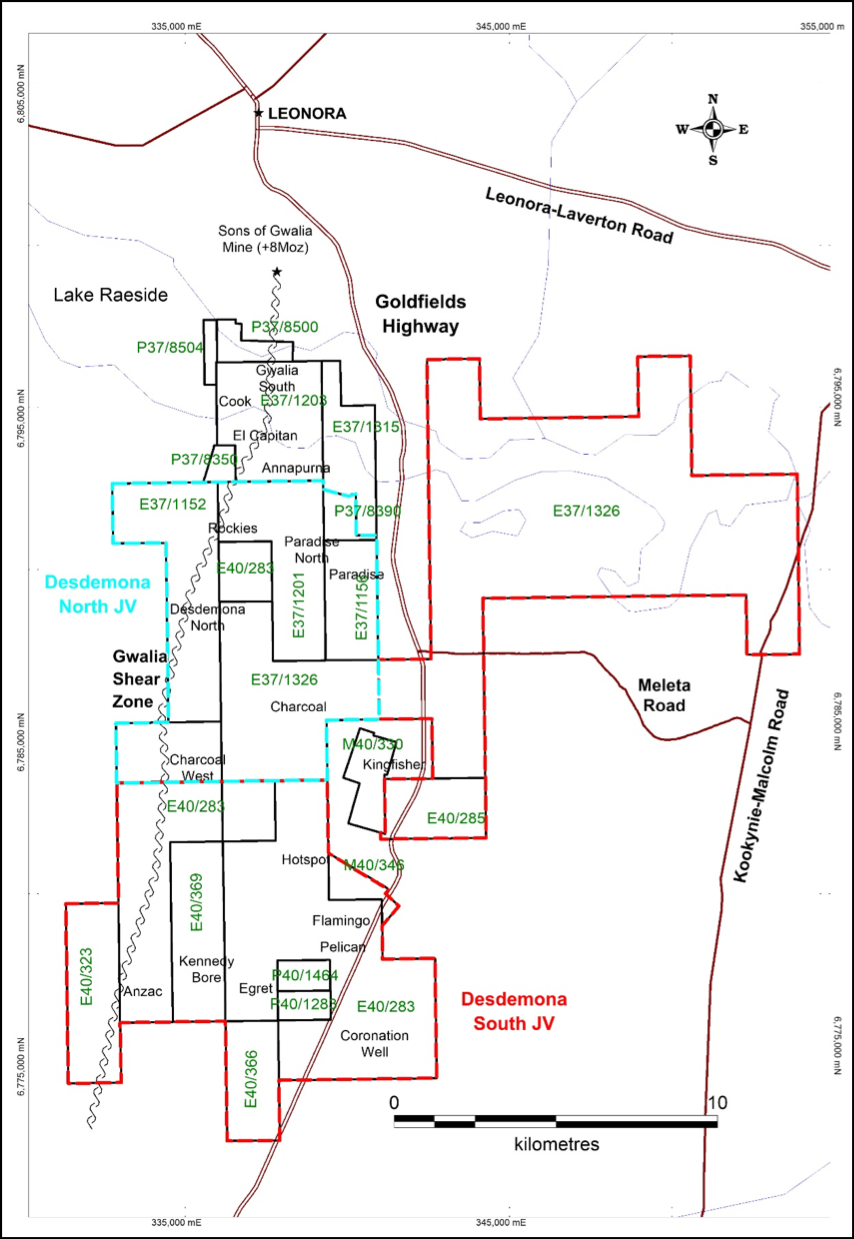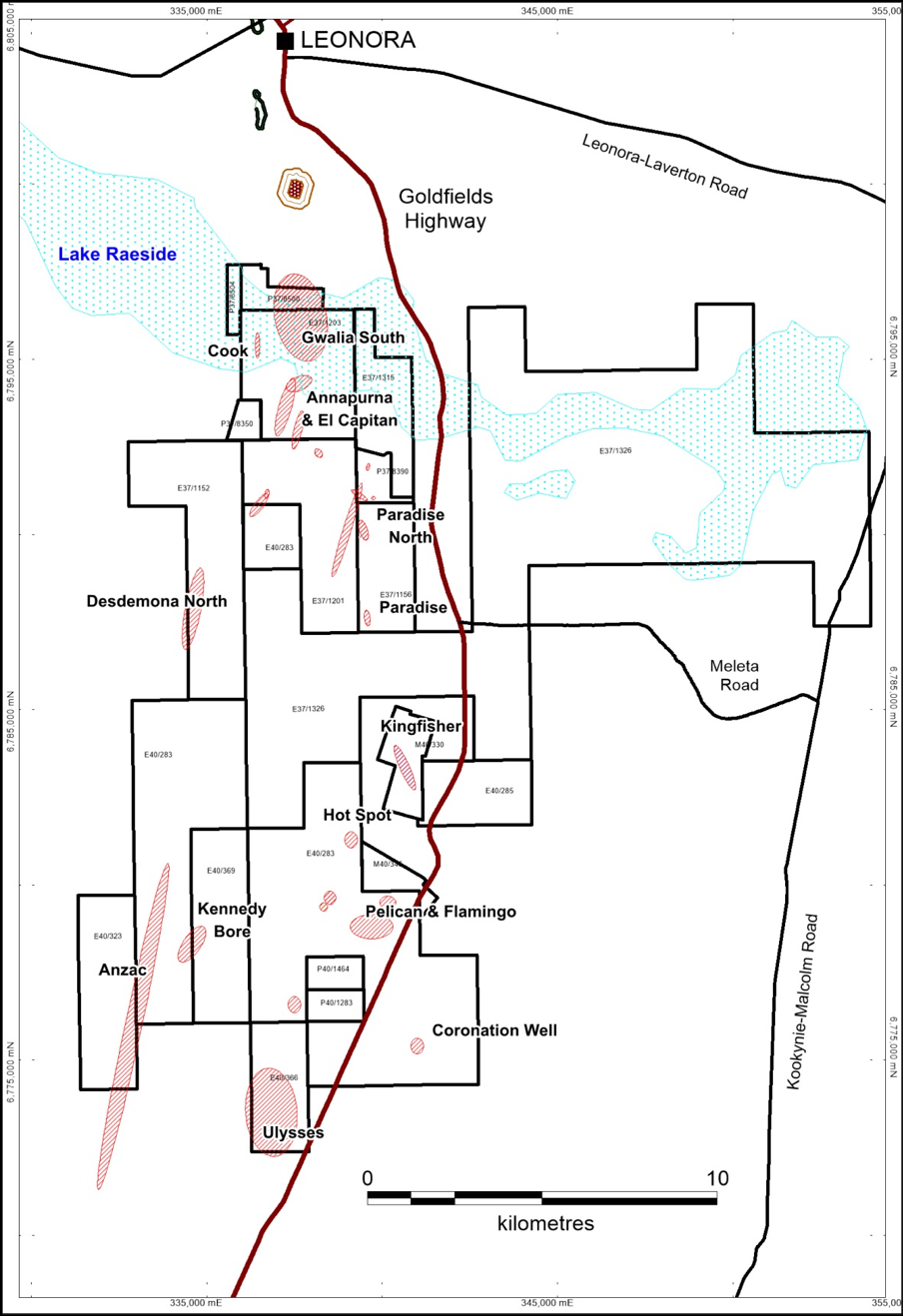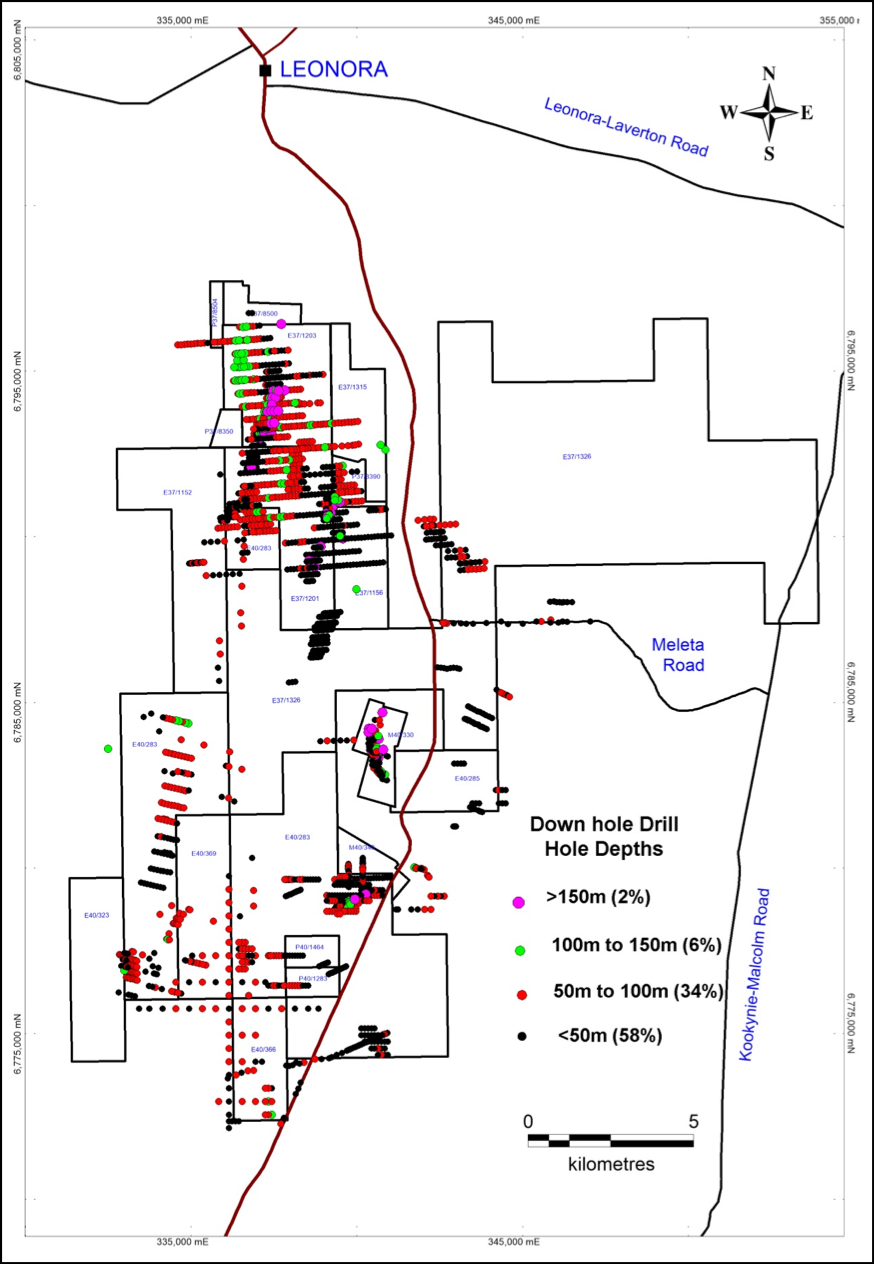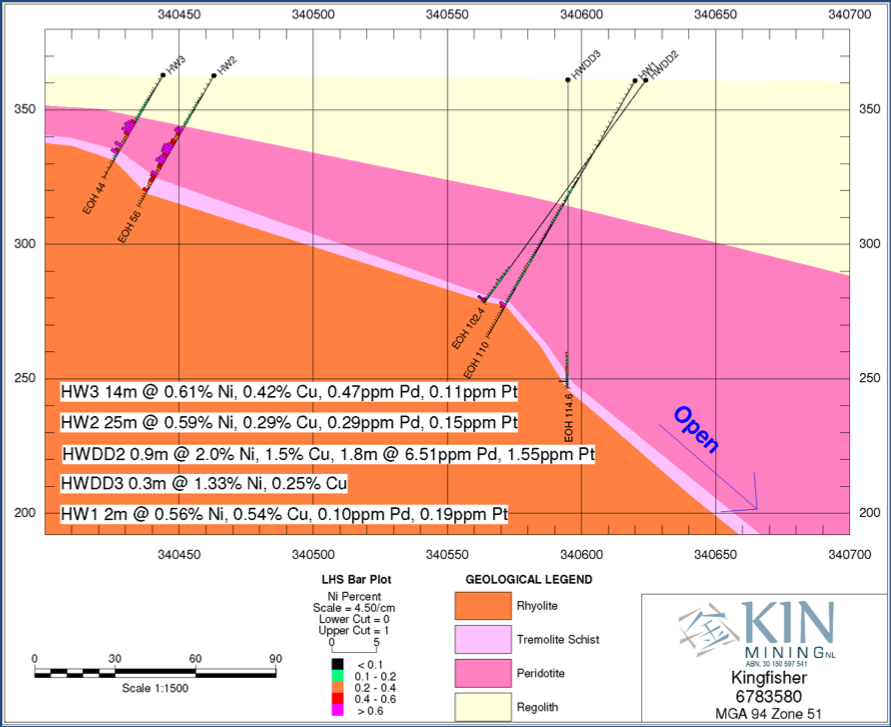The Desdemona Project consists of eleven (11) Exploration Licences, six (6) Prospecting Licences and two (2) Mining Leases. The Project covers a large, contiguous area (268.3 sqkm) immediately south of Leonora and 2.5km south of the long-life, high-grade Sons of Gwalia mine. The Project covers the western side of the Melita Greenstone Belt in contact with the Raeside Granitic Batholith and extends as far east as the Kookynie Road. The greenstone stratigraphy strikes generally north-south to northeast-southwest and is offset by several strike-slip faults. The Gwalia and Mt George Shear Zones form the margin between the granitoids to the west in contact with the greenstones package. To the east the Project is bound by the Emu Fault and the eastern extensions of Lake Raeside.
In December 2019 the Company entered farm/earn-in arrangements with two entities over the Desdemona Project ground.
Tenements overlie a typical Archaean greenstone and meta-sedimentary sequence intruded by sill-like bodies of mafic and ultramafic rock. Mafic lavas, rhyolites and dacites predominate in the sequence, with dolerites and gabbro being the dominant intrusives. Regolith cover is variable however, the area is extensively masked by recently transported cover. The project is regarded as a mature but underexplored holding as it displays very good potential for the discovery of economic gold, nickel, PGEs and base metal mineralisation.
Early exploration activities at Desdemona were hindered by the presence of the widespread transported cover, high water flows and deep clays. Many previous drill programs fail to reach target depth and in several cases bedrock testing could not be achieved. Nonetheless the Project has generated numerous target zones that require follow up investigation. The area displays anomalous historical geochemical soil and drill results over several buried targets scattered over a large area however, continuity of mineralisation defined to date is limited and no bedrock source of the identified mineralisation has been discovered.
The majority of the Project is subject to two Joint Venture (JV) agreements, announced on 20th December 2019. The Desdemona North JV (61.5 sqkm), earn-in agreement with privately owned Yilgarn Exploration Ventures and Desdemona South JV (156 sqkm) earn-in agreement with Genesis Minerals Ltd (ASX: GMD). Genesis have delineated 760,000oz of Mineral Resources at Ulysses, a gold project located on the adjoining tenements immediately south of the Desdemona South JV Project.
Over the last 40 years numerous gold and nickel-copper-PGE drill targets have been outlined and superficially drill tested. Drilled and prospective target areas include:
- Annapurna which returned 4m @ 15.13g/t Au (170-174m) together with numerous anomalous aircore and RC drill results.
- Kingfisher which returned 1.83m @ 1.14%Ni, 0.77% Cu, 7.96g/t PGE and 1.22g/t Au.
- Gwalia South tenement package 2.5km south of the Sons of Gwalia Mine (+11 M oz)
- Paradise and Paradise North returned 6m @ 1.34g/t Au in an area which displays structural trends sub-parallel to the Gwalia Shear Zone.
- Cook prospect which returned 10m @ 0.94g/t Au and 3m @ 2.6 g/t Au in granite.
- The Pelican prospect which returned 8m @ 22.48g/t Au from 60m in HWA037 within a zone over one of the two large (+1000m x +200m) gold-in-soil anomalies (Pelican and Flamingo).
The Hotspot prospect which revealed a rock chip sample grading 16.6g/t Au.



Annapurna and Gwalia South
The Annapurna Prospect together with the Gwalia South Prospect is located in the north of the Project (E37/1203). The tenement group covers the southern strike extension of the Gwalia Shear Zone, a highly prospective zone of ductile deformation that extends south from the nearby Sons of Gwalia mine (+8Moz). The northern group of tenements covers the mafic and ultramafic volcanic sequence that host the mine sequence. The same greenstone package encompasses the granite-ultramafic contact that hosts both Tower Hill (1Moz production) and Tarmoola (+2Moz production) mines.
Historic drilling results at Gwalia South, which has not been followed up, returned
- 4m @ 1.35g/t Au from 10m to EOH (City Resources) SGR012 – Gwalia mine sequence.
- 3m @ 2.4g/t Au from 60m (Sons of Gwalia) CWA510 in granite.
- 0m @ 1.56g/t Au from 95.8m (WMC) GSD005 – the Gwalia slate.
Interpretation suggest that mineralisation in GSD005 and SGR012 may be continuous and represent a NW trending gold corridor within the Gwalia mine sequence that requires angled RC drilling assessment. Multiple significant (>0.1 g/t Au) drill intercepts occur over a strike length of 5km under cover, along or close to the interpreted position of the Gwalia Shear Zone.
Further south at Annapurna an intersection in quartz veining on the granite-ultramafic contact returned
- 4m @ 15.13g/t Au (170-174) including 1m @ 45.83g/t Au (CWC779)
The geological setting is similar to that at Harbour Lights and Tower Hill deposits. The area presents as a priority drill target that warrants further geological evaluation and drilling. The prospect contains sparse drill patterns on nominally 400m spacing and although generating several significant intersections and intersecting the prospective sheared mafic/ultramafic ± felsic porphyries overlying felsic/sedimentary units the area is relatively untested. Other prospects include El Capitan which hosts potassic and carbonate alteration in mafic and ultramafic rocks similar to Harbour Lights and the Sons of Gwalia mine.
Drill testing by Kin Mining, Sons of Gwalia and St Barbara has confirmed that the Gwalia Shear Zone continues south along the granite-greenstone contact. Gold mineralisation has been identified in mafic and ultramafic schists above the contact, see announcement 31st October 2016. Other prospective areas include Cook, Rockies and Nevis prospects which have returned low level gold anomalism associated elevated tungsten (W) and bismuth (Bi).
The northern tenements in the Desdemona holding (P37/8500, P37/8504, E37/1203 & E37/1201) are regarded as highly prospective and host the same lithological sequences that at Leonora and further north of are of mineable grade (i.e. Sons of Gwalia, Tower Hill, Harbour Lights and Tarmoola). The Gwalia South region is regarded as poorly tested and the source of the mineralisation has not been defined, further investigation is warranted.
Many target areas remain untested. Previous exploration was predominately ineffective due to the drilling being widely spaced, vertical and only drilled to blade refusal. Historical drilling often failed to intersect the prospective contacts. In many cases deeper, angled RC drilling is required to effectively explore this highly prospective structural corridor.
Kingfisher
The Kingfisher Ni, Cu and PGE target (M40/330) is associated with basal contact nickel mineralisation, a brecciated basal ultramafic-rhyolite contact striking over 450m and a potential feeder conduit zone of sulphur saturated tholeiitic mafic-ultramafic intrusions. The tenement hosts a typical Archean assemblage intruded by sill-like bodies of mafic and ultramafic rocks. Basic lavas of basaltic to spilitic type, with rhyolite and dacitic lavas and tuffs forming most of the fundamental sequence, dolerites are the most abundant intrusive. The sequence is part of a large open syncline with a NE trending axis.

The prospect displays historic diamond drill intersections (Glomex 1970-1971) on a brecciated contact of:
- 9m @ 2% Ni and 1.5% Cu from 101.2m and 1.8m @ 1.55 g/t Pt and 6.51 g/t Pd from 100.6m (HWDD2).
- 3m @ 1.33% Ni and 0.25% Cu from 111.9m (HWDD3).
- 3m @ 0.75% Ni and 4.8% Cu from 152.7m (HWDD6) – deepest intersection is 130m vertical depth.
- 5m @ 0.81% Ni and 0.65% Cu from 68.9m (HWDD4).
- 0m @ 0.65% Ni, 0.99% Cu, 0.45 g/t Pt, 0.6 g/t Pd and 360 g/t Co from 78m (HWP9).
Anomalous bedrock intersections have delineated a zone of Ni-Cu-PGE enrichment. The high magnetic signature of rocks at Kingfisher indicates that the interpreted basal ultramafic contact extends over a strike length of at least 1.4km. The depth extensions of this contact are unknown and have not been tested by drilling. The majority of historical drilling has focused on the shallow hanging wall (western side) of the ultramafic sequence.
The largest sulphide segregation was intersected in HWDD2 and consisted of 0.9m of richly mineralised rhyolite breccia. Angular fragments of rhyolite are separated by up to 10cm of sulphide minerals and the fragments themselves often contain sulphide veinlets.
KIN’s geological team has identified an extensive zone of strong secondary Ni-Cu-Co-PGE surface enrichment at Kingfisher correlating with the historical basal contact ore grade nickel and copper sulphide, with associated platinum and palladium intersections (HW3 & HW2).
In 2014 Kin identified Kingfisher as a primary exploration target and undertook MLEM and DHEM geophysical surveys which identified two electromagnetic conductors. Kin subsequently completed RC drilling (KF14RC001-004 for 1205m) which targeted the electromagnetic conductor KFC2, as announced 22nd October and 27th November 2014.
Elevated Ni intersections were returned from the initial holes. The fourth RC drill hole intersected a very narrow sulphide rich horizon (269-270m) a fifth hole was drilled in 2016. The mineralisation intersected to date does not adequately explain the electromagnetic geophysical response.
The EM conductors and the basal ultramafic contact have not been effectively tested, particularly in the north and at depth. Exploration activities remain ongoing and additional down hole geophysical surveys and deeper drilling below the known mineralisation is the exploration strategy.
Paradise and Paradise North
The Paradise Prospects, which are located on tenements P37/8390, E37/1201 and E37/1156, are characterised by a grouping of ore grade intercepts in historical drill holes, positioned on the western margin of the Paradise Shear Zone. On the eastern margin of this shear zone, a gossanous mylonite unit crops out over a strike length of around 850 meters and dips around 35° to the east.
Several historic prospecting pits and shafts were noted in this area. Rock chip sampling of these old workings by KIN personnel in October 2013 returned gold assays of up to 1.12g/t, see ASX announcement 24th December 2013, and has identified the area as worthy of further investigation.
The Paradise North Prospect covers an area of extensive gold anomalism associated with a north-east trending aeromagnetic lineament parallel to the Butchers Flat Shear. In the northern part of the anomalous zone, gold mineralisation is hosted by quartz-sericite schist containing quartz-limonite-pyrite veins in the southern part of the anomaly. Potassic and carbonate alteration is associated with the gold anomalism. Previous aircore drilling defined a zone of supergene gold mineralisation, including a best historic gold intersection (Sons of Gwalia Ltd aircore drill program 1999) of 12m @ 3.57 g/t Au including 3m @ 13.3g/t Au from 42m in CWA728.
Historical drilling around CWA728 is limited to two RC holes that are reported to be of low grade. Drilling was widely spaced, carried out on 150m line spacing’s north and south of the significant intersection in CWA728.
Kin believes that there is scope to identify the source of the high-grade supergene gold enrichment.
Historic drilling around the mineralisation is limited and the system remains open. Other nearby significant intersections from vertical drilling along the Paradise Shear Zone returned:
- 3m @ 4.40 g/t Au from 30m and 12m @ 2.04 g/t Au from 48m (CWA757)
- 3m @ 8.15 g/t Au from 30m and 6m @ 0.90 g/t Au from 42m (CWA 734)
- 7m @ 1.8 g/t Au from 45m EOH including 2m @ 3.23 g/t Au (CWA737)
- 2m @ 2.86 g/t Au from 63m (CWA578)
First pass exploration RC drilling by Kin at Paradise (2016) returned several anomalous results with a best RC intersection of:
- 1m @ 0.97 g/t Au (47-48m) and 1m @ 0.86 g/t Au (73-74m) in PD16RC001.
The recent drilling failed to confirm or extend the historical results, the source of the gold mineralisation has not been identified.
Pelican
South of Kingfisher, two prospects, the Pelican and Flamingo prospects (E40/283 and M40/346) have been identified by east-west Au gold-in-soil anomalies (1000m x 200m). The prospects have been historically soil sampled and drilled.
Gold mineralisation at the Pelican prospect occurs within a broad, NE trending zone of quartz veining and sericite-pyrite-arsenopyrite alteration hosted by a felsic volcanic unit (quartz-feldspar porphyry). The mineralisation can be traced over a strike length of almost 1.5km; the zone remains open along strike in both directions. The mineralised structure trends parallel to strike of the stratigraphy and dips at a shallow angle (approximately 30° to the SE).
Aircore and RC drilling at the Pelican Prospect (Drake Resources 2007) include the following shallow intersections:
- HWA037 8m @ 22.48g/t Au from 60m and HWA038 8m @ 2.09g/t Au from 52m
- HWA115 1m @ 9.23g/t Au from 47m and HWA124 3m @ 8.05g/t Au from 45m
- HWA125 3m @ 2.11g/t Au from 47m and HWRC003 3m @ 2.11g/t Au from 51m
Limited deeper RC and diamond drilling was drilled to test the structures below the oxide zone. Several narrow, high grade intersections have been reported.
- HWRC001 1m @ 5.64g/t Au from 104m and HWRC002 1m @ 9.29g/t Au from 111m
- HWRC005 1m @ 5.060g/t Au from 110m and HWRC010 1m @ 2.66g/t Au from 94m
Drilling by Kin at the Pelican Prospect was completed during 2014 with 3 RC holes drilled for a total of 404m. PL14RC003 reported several intervals with anomalous gold assays, with a best result of:
- 3m @ 1.04 g/t Au from 109m.
The supergene mineralisation at Pelican remains open in several directions and the source of the gold enrichment is unknown. The nearby Flamingo Prospect also displays anomalous gold-in-soil results over a large area extending into M40/346. Historical aircore drilling has outlined a felsic hosted bedrock gold anomaly that is open to the west and north, the majority of which has not been drill tested.

